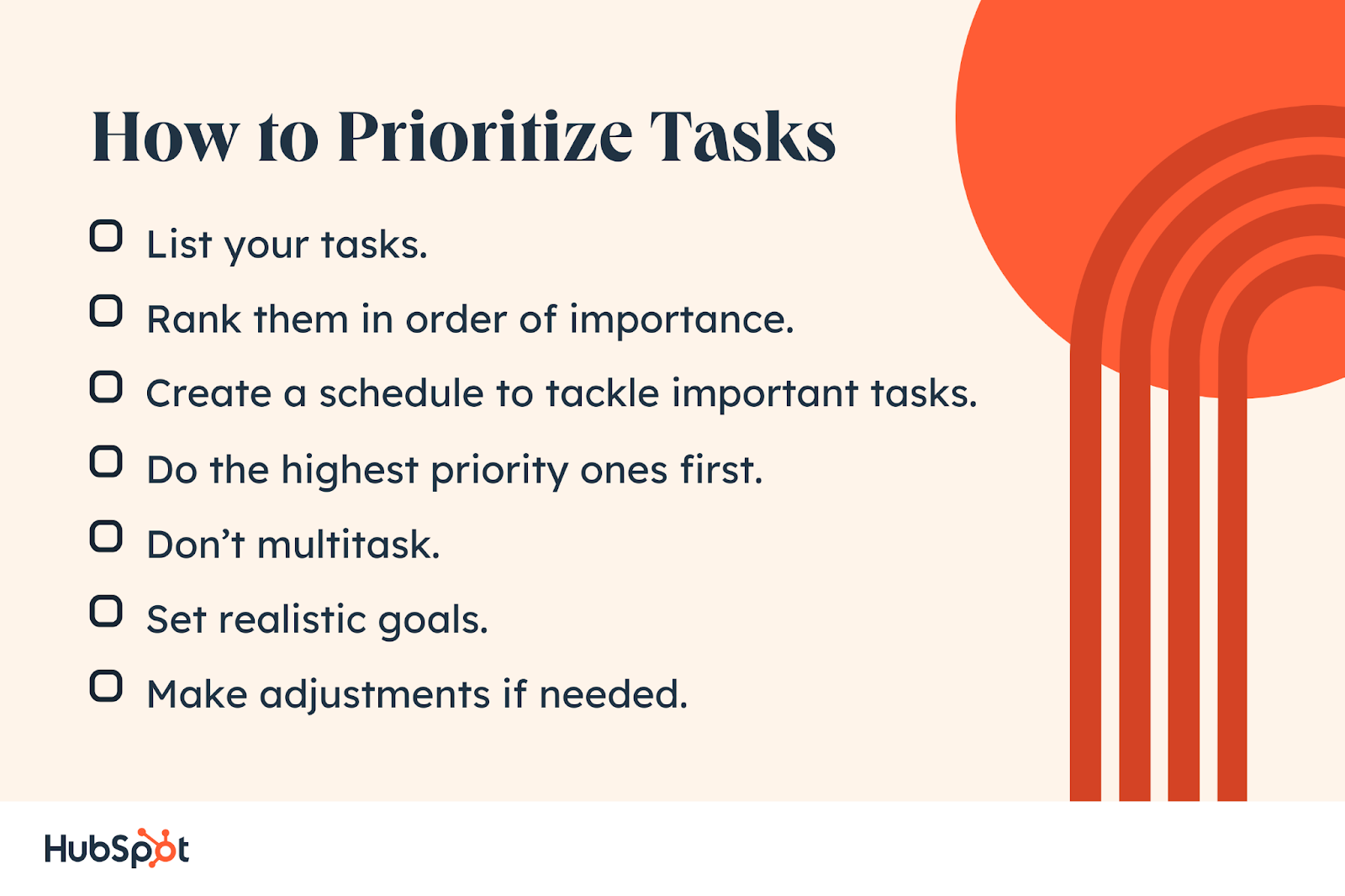Disorganization can be an accidental lifestyle for those who haven’t learned how to effectively prioritize their tasks. Like water, it seeps into whatever you’re not successfully managing until you look around and realize you’re drowning in details.

If you’re in that boat, you’re in good company. Hugely successful professionals pay handsomely for great admin support to bring order to their chaos. If outsourcing is outside of your budget, you can still make smart choices about how to prioritize your responsibilities and better manage your time.
Prioritization Methods
Did you know there are far more interesting — and more effective — methods for prioritizing your to-do’s than just working your way down a seemingly endless list? Various strategies lend themselves to different personalities and energy levels, so make sure you try more than one to see what works best for you.
The Eat the Frog Method
The infamous frog is the task that you are most dreading. Our frogs are usually difficult tasks, due soon, or involve steps that give us anxiety.
The Eat the Frog method encourages you to get what you perceive as the worst thing done first. This method can boost mood and productivity because you won’t have the stress of the task looming over you, and subsequent tasks don’t seem so bad in comparison.
This strategy for how to prioritize your tasks works particularly well for people whose highest energy levels are first thing in the morning before the day starts weighing you down.

The ABCDE Method
Some people are motivated by the consequences connected to the tasks at hand. If this is you, try the ABCDE method. It starts with your list of tasks, so build that first. Then, you categorize the tasks by marking each of them with one of these letters:
A — Mark tasks with an A if they are really important and come with big consequences. This would be your frog in the previous method.
B — Mark tasks with the letter B if the consequences aren’t as severe if they don’t get done.
C — If tasks don’t really connect with a consequence but should be done, mark them with a C. Save these to fill any extra time after your A and B tasks are complete.
D — D is for delegate. Mark with a D if you can reasonably reassign them to someone else.
E — E is for eliminate. It means cutting these tasks out. Sometimes, we have tasks in mind that seem important, but are they really important enough to take time away from the A and B tasks? If not, take them off your list.
You don’t need them taking up brain space or making your list overwhelmingly long right now. They may eventually show up on your list again when they grow in importance — but today is not the day.

Eisenhower Matrix
Is visually organized data more your speed? Do your co-workers think of you as a charts and graphs guru? The Eisenhower matrix has similarities to ABCDE, but is more visual and skips the letter C entirely.
It organizes your responsibilities according to four criteria:
- Urgent
- Not urgent
- Important
- Not important
Where importance and urgency levels converge determines what to do with the task:
- Important and Urgent? Do it now.
- Important but not Urgent? Schedule it for later.
- Urgent but Not Important? See if you can delegate it.
- Not Urgent and Not Important? Chuck ‘em! These tasks waste your time.

Steps for Prioritizing Tasks
Ready to jump in? Here are actionable steps and good advice you can use right now!

1. List your tasks.
Write down or type in a list of every task, appointment, meeting, lunch date, play date, dry cleaning pick-up — whatever it is you are responsible for managing and want to get organized. This list is a task in itself, so your list needs to include planning time to make your list, rank the tasks, schedule them, etc.
Depending on what your work cycles look like, you could save some planning time by just repeating your list for each day, each week, each month, or more. You choose the time scale that works best for you.
2. Rank them in order of importance.
Once you have your tasks listed, it’s time to rank them. This can be low-tech by numbering them on your paper or involve any of the three methods we explained above, like the Eisenhower Matrix or ABCDE method.
There are all kinds of productivity apps with useful tools — like color coding — so you can identify at a glance which are your most important tasks each day, week, month, etc.
If you liked the idea of the Eat the Frog method, pick the most daunting of your important tasks and prepare yourself to face that beast down to the ground next Monday morning.
3. Create a schedule to tackle the most important tasks.
There are tons of scheduling strategies out there, but we’re going to allude to number 5 on this list — don’t multitask. Your most efficient, effective — and creative — work will happen when you are focused on just one thing.
Two of the most well-known ways to schedule uninterrupted time are practicing the Pomodoro Technique and time blocking:
Time blocking is pretty straightforward. You choose a task or a bundle of related tasks and dedicate a chunk of time on your schedule to only that task. No Slack, no email, no social, no calls. It’s a protected block of time to focus.
The Pomodoro Technique is a great option if your tasks are dreadfully boring, your natural attention span is short, or if your tasks can be broken down into steps that take about 25 minutes to complete. It helps keep you motivated because you know it won’t be long before you get a break — the breaks are a vital part of the technique.
You schedule half an hour on your calendar but set a timer for 25 minutes. You give total focus for 25 minutes, then stop and take a 5-minute break. It’s easy to use your 5 minutes “wrapping up an idea” sometimes, but set a mental boundary for yourself so you protect the 5 minutes and really use it. Take a walk, get a drink, look out a window, pet your dog if you work from home, etc.
You repeat that pattern four times over two hours, then take a longer break — 20 or 30 minutes. This method helps you be productive through tasks you’re not highly motivated to just slog through.
4. Do the highest priority ones first.
This isn’t necessarily Eating the Frog. If you have something due by noon but can also work on a frog task that isn’t due until the end of day, make sure you prioritize meeting your noon deadline.
5. Don’t multitask.
And don’t pressure others to multitask! It was a great mistake of the late 90’s that great workers can and should multitask to be more productive. It was a selling point on resumes, but it was bringing real harm to the workforce. Yikes.
It turns out that almost no one was doing more than one thing at a time — they were quickly switching between tasks. That doesn’t sound so bad, but research over the past 20+ years indicates that cognitive switching is mentally draining every single time. And it adds up fast, leading to lower productivity, higher stress, and more burnout.
It helps to treat tasks more like Henry Ford would. Focus on one thing until it’s done to increase efficiency. Protect this deep work time for each task by setting your Slackmoji to Heads Down and your phone to Do Not Disturb.
6. Set realistic goals.
Unrealistic ambition can be inspiring! Imagine a child who wants to be a construction worker/astronaut/lemonade tycoon/unicorn trainer/chef. But experience tells us that it’s hard to do one thing, let alone more than one simultaneously. Pandemic parents could fill a library with their unrealistic goals from when schools closed.
So take the lesson, and be honest with yourself about limitations and constraints. Then, only plan what you can realistically complete in the timeframe you are scheduling. Nothing can throw off your morale and productivity like finding out you short-changed yourself on vital time you needed for an important task.
7. Make adjustments if needed.
Try not to feel too discouraged if the strategies you pick only last for a short time before going off the rails. It’s a process! You’re building up both a new management skill and a habit — which are different things.
Try to identify if you need to focus on habituating your chosen method, if you would benefit from tweaks to the method you’re using, or if you need to scrap the attempt and try a different method altogether.
One of the most common tweaks is correcting how much time certain tasks actually take. You may find that a common task doesn’t take as long as you thought, or you may discover that 5 minutes was too rosy an estimate to walk to your favorite lunch spot.
It’s important to note that not every brain is wired to recognize and organize time. Once you’ve found how to prioritize your tasks in a way that makes sense to you, the next step is finding a method or tool to help you schedule your time in a way that works for you, too.
We mentioned time blocking and the Pomodoro Technique, but there are lots more methods, scheduling apps, and calendar systems to explore. Keep trying until you find a good fit! Developers are creating new and more diverse solutions all the time to help you manage time and task management.
Start Prioritizing Today
Using the methods, strategies, and steps listed above, you can get a better handle on your to-do list and begin to prioritize your tasks appropriately. You’ll find you’re both more peaceful and productive in facing the work you need to accomplish daily and weekly.
Editor's note: This article was originally published in September 2014 and has been updated for comprehensiveness.




![The Best Time of Day to Do Everything, According to Science [Infographic]](http://53.fs1.hubspotusercontent-na1.net/hubfs/53/peak-time-of-day.jpg)
![Where Time Gets Lost at Work (And How to Get It Back) [Infographic]](http://53.fs1.hubspotusercontent-na1.net/hubfs/53/00-Blog_Thinkstock_Images/lost-time-at-work.jpg)

